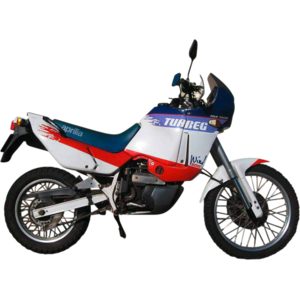Aprilia Tuareg 600 [1992-1993]: The Rough Diamond of 90s Adventure Motorcycling
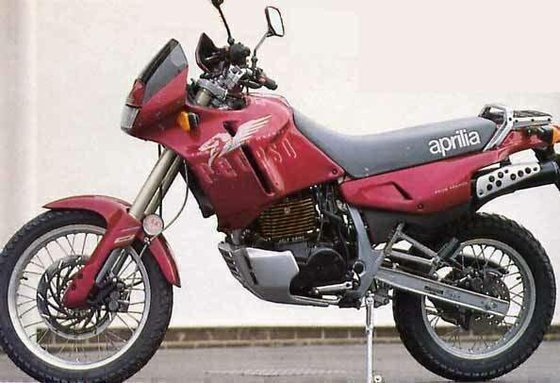
Introduction
The Aprilia Tuareg 600 stands as a fascinating artifact of 1990s motorcycle design—a bike that dared to blend Italian flair with Austrian engineering grit. Produced for just two years, this air-cooled single-cylinder adventurer carved out a niche for riders seeking character over conformity. With its Rotax-derived powerplant and trail-ready geometry, the Tuareg 600 wasn’t just a motorcycle; it was a statement about what "adventure" could mean in an era dominated by plasticky fairings and increasingly sanitized performance.
This review isn’t just a nostalgia trip. Climb aboard, and you’ll find a machine that still speaks clearly to riders who value mechanical honesty and a connection to the road (or dirt) that modern bikes often filter out. Let’s dissect why this underdog deserves a second look—and why it might just convince you to browse our aftermarket catalog at MOTOPARTS.store.
Design & Aesthetics
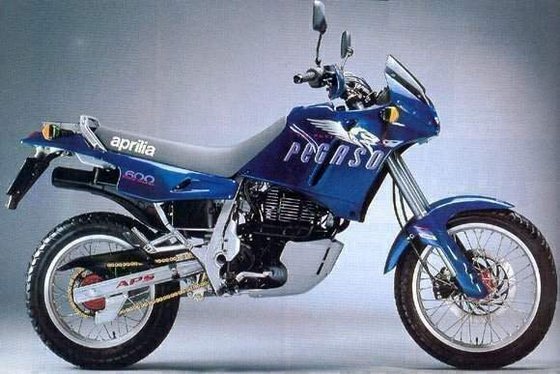
Aprilia’s 1990s design language was flamboyant—think neon graphics and aggressive angles. The Tuareg 600, however, took a different path. Its styling was refreshingly restrained, relying on clean lines and functional proportions rather than shouty decals. The frame-mounted fairing, with its single round headlight (a late revision from the original twin-beam setup), gave it a purposeful, almost military demeanor. The dummy tank—a clever cover hiding the steel tube frame—added to its minimalist charm, while the deep metallic paint options (think raspberry reds and muted silvers) whispered sophistication rather than screaming for attention.
At 148 kg (326 lbs), the Tuareg felt shockingly light on its feet compared to bulkier Japanese competitors. The 860mm seat height might intimidate shorter riders, but the narrow chassis made dab-and-go maneuvers manageable. Every component, from the upswept exhaust to the high-mounted front fender, screamed dual-purpose intent—though as we’ll see, this was a wolf in sheep’s clothing, better suited to tarmac than true trail blazing.
Engine Performance: The Rotax Heartbeat
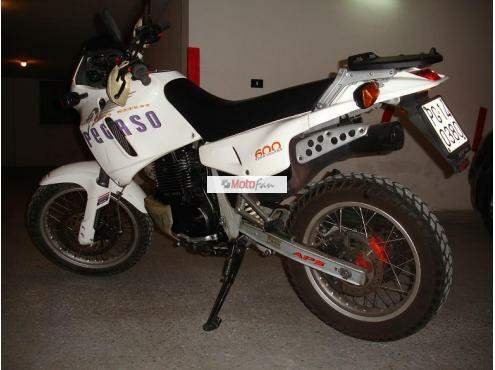
Specs at a Glance:
- Engine: 562cc air-cooled single-cylinder, SOHC, 4 valves
- Power: 46 HP @ 7,000 rpm / 34 kW
- Torque: 48.75 Nm (36 lb-ft) @ 6,500 rpm
- Compression: 9.4:1
- Induction: Dell’Orto PHBH 34 carburetor
The Rotax-engineered powerplant was the Tuareg’s centerpiece—a “rough diamond” that balanced agricultural charm with surprising sophistication. Cold starts required patience (thankfully aided by both electric and kickstart systems), but once warm, the single-cylinder thumper settled into a lumpy idle that vibrated through the bars like a caffeine tremor.
On the Road:
Below 3,000 rpm, the Tuareg felt hesitant, its carburetion snatchy in low gears. But past that threshold, the engine transformed. Torque piled on linearly from 4,000 rpm, delivering a satisfying shove that made overtaking effortless. By 6,000 rpm, the vibrations intensified—handlebars blurred, mirrors became useless—but the exhaust note deepened into a metallic bark that egged you on. Redlining at 7,500 rpm felt genuinely sporty for a big single, though most riders instinctively short-shifted to preserve sanity.
Real-World Performance:
- 0-100 km/h (0-62 mph): ~6.5 seconds (deceptive due to the torque-heavy delivery)
- Top Speed: 160 km/h (100 mph)—achievable with a tuck, but vibrations made sustained runs exhausting
The dry-sump lubrication and oil cooler (mounted behind the fairing’s right-side vent) kept temperatures in check, even during spirited summer rides. Compared to water-cooled rivals like the Yamaha XT600, the Tuareg’s air-cooled simplicity was a blessing for DIY maintenance—though it demanded respect in stop-and-go traffic.
Handling & Ride Experience
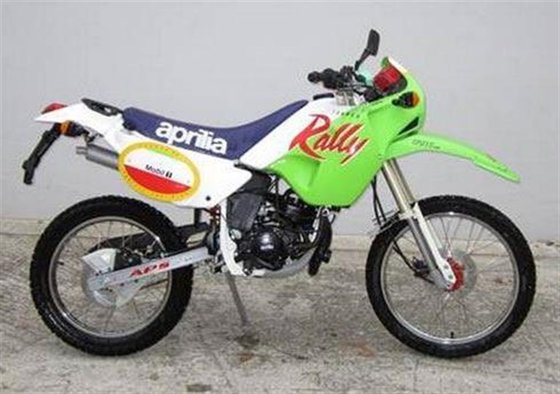
Suspension Setup:
- Front: 39mm inverted forks, 203mm (8”) travel
- Rear: APS monoshock, 203mm (8”) travel
Aprilia pitched the Tuareg as a road-biased adventurer, and the suspension setup made that clear. The plush, non-adjustable forks and slightly firmer monoshock prioritized comfort over precision, soaking up potholes and cobblestones with almost comedic ease. On broken backroads, it felt invincible—a magic carpet ride that laughed at surface imperfections.
Weaknesses Exposed:
Push harder, though, and the chassis showed its limits. The front end lacked feedback, turning vague mid-corner, while heavy braking induced alarming fork dive. On wet roads, the Pirelli MT60 tires (100/90-19 front, 130/80-17 rear) struggled to transmit confidence, exacerbated by the soft suspension’s reluctance to settle.
Ergonomics:
The riding position split the difference between dirt bike and roadster. Wide handlebars offered leverage for low-speed maneuvers, while the slightly rear-set pegs (with rubber dampers for highway comfort) encouraged active riding. The bench seat, firm yet supportive, handled all-day rides better than modern ADV offerings.
Competition: How It Stood Against the 90s Rivals
The Tuareg 600 faced fierce competition in the “big single” arena. Here’s how it stacked up:
1. Honda NX650 Dominator
- Pros: Bulletproof reliability, iconic styling, lower seat height
- Cons: Heavier (163 kg / 359 lbs), softer power delivery
- Verdict: The Dominator was the safer choice, but the Tuareg outpunched it in character and agility.
2. Suzuki DR650S
- Pros: Legendary off-road capability, torquier engine
- Cons: Rudimentary suspension, cheaper finish
- Verdict: The DR650 ruled the dirt, but the Tuareg’s road manners and premium feel made it the better urban adventurer.
3. Yamaha XT600E
- Pros: Liquid cooling, broader powerband
- Cons: Bland styling, heavier feel
- Verdict: The XT600 was technically superior, but the Tuareg’s Italian flair and lighter chassis gave it an emotional edge.
The Aprilia’s Ace Card? Its exclusivity. While Japanese rivals flooded the market, the Tuareg 600 felt special—a bike for riders bored of mainstream options.
Maintenance: Keeping the Tuareg Thriving
Owning a 30-year-old Italian-Austrian hybrid isn’t for the faint-hearted, but the Tuareg rewards those who stay proactive. Here’s your MOTOPARTS.store checklist:
1. Valve Adjustments
- Intake/Exhaust Clearance: 0.05mm (0.002”) cold
- Frequency: Every 5,000 km (3,100 miles)
- Pro Tip: Use a feeler gauge and patience—the Rotax head is accessible but finicky.
2. Carburetor Tuning
- Pilot Screw: 1.5 turns out (baseline)
- Idle RPM: 1,200–1,400 rpm
- Upgrade Path: Consider a Mikuni TM36 flat-slide carb for crisper throttle response.
3. Chain & Sprockets
- Stock Gearing: 18T front / 42T rear
- Chain Type: 520 O-ring
- MOTOPARTS.store Picks: DID 520VX2 chain, JT Steel sprockets
4. Suspension Refresh
- Front Fork Oil: 530ml per leg, SAE 10W
- Rear Shock: APS monoshock rebuild kits available
- Upgrade Alert: Hyperpro springs transform road handling.
5. Electrics
- Spark Plugs: NGK D8EA (standard), DR8EIX (iridium upgrade)
- Electrode Gap: 0.6mm (0.024”)
6. Critical Fluids
- Engine Oil: 2.0L SAE 15W-40 (2.1 qt with filter)
- Brake Fluid: DOT 4
- Coolant: Air-cooled (no radiators to worry about!)
Conclusion: Why the Tuareg 600 Still Matters
The Aprilia Tuareg 600 wasn’t perfect. Its suspension was too soft, its vibes too intense, and its off-road prowess too limited. But that’s precisely why it’s compelling today. In an age of electronic nannies and homogenized performance, this bike reminds us that motorcycling is about feel—not just figures.
For owners, MOTOPARTS.store stands ready to keep your Tuareg alive with quality aftermarket parts. Whether you’re chasing OEM-style replacements or performance upgrades, we’ve got the goods to make this 90s underdog bark louder than ever.
Ride vintage. Ride vibrant. Keep adventuring.
Specifications sheet
| Engine | |
|---|---|
| Stroke: | Four-stroke |
| Max power: | 34 kW | 46.0 hp |
| Max torque: | 49 Nm |
| Fuel system: | Dell'Orto Ø34 mm carburetor |
| Max power @: | 7000 rpm |
| Displacement: | 562 ccm |
| Max torque @: | 7000 rpm |
| Configuration: | Single |
| Cooling system: | Air-cooled |
| Starting system: | Electric and kick |
| Compression ratio: | 9.4:1 |
| Number of cylinders: | 1 |
| Dimensions | |
|---|---|
| Dry weight: | 148 |
| Fuel tank capacity: | 12.0 L (3.2 US gal) |
| Drivetrain | |
|---|---|
| Final drive: | chain |
| Chain length: | 118 |
| Transmission: | 5-speed |
| Rear sprocket: | 42 |
| Front sprocket: | 18 |
| Maintainance | |
|---|---|
| Rear tire: | 130/80-17 |
| Engine oil: | 15W40 |
| Front tire: | 100/90-19 |
| Idle speed: | 1200–1400 rpm |
| Break fluid: | DOT 4 |
| Spark plugs: | NGK D8EA or NGK DR8EIX |
| Spark plug gap: | 0.6 |
| Coolant capacity: | N/A (air-cooled) |
| Forks oil capacity: | 1.06 |
| Engine oil capacity: | 2.5 |
| Engine oil change interval: | Every 5000 km or 2 years, whichever comes first |
| Valve clearance (intake, cold): | 0.05 mm |
| Valve clearance check interval: | 18,000 km / 11,000 mi |
| Valve clearance (exhaust, cold): | 0.05 mm |
| Recommended tire pressure (rear): | 1.8 bar (26 psi) |
| Recommended tire pressure (front): | 1.7 bar (25 psi) |
| Chassis and Suspension | |
|---|---|
| Rear brakes: | Single disc with single-piston caliper |
| Front brakes: | Single disc with twin-piston caliper |
| Rear suspension: | APS monoshock |
| Front suspension: | Hydraulic upside-down fork, non-adjustable |
| Rear wheel travel: | 203 mm (8 in) |
| Front wheel travel: | 203 mm (8 in) |



